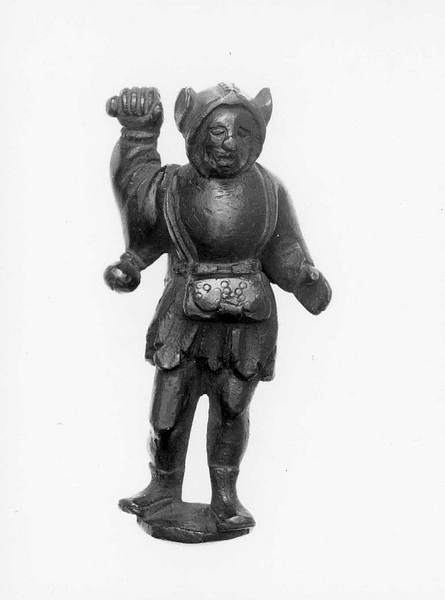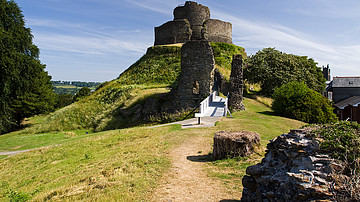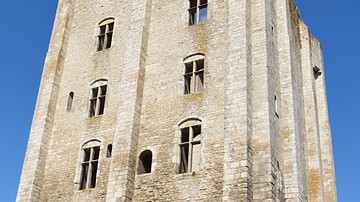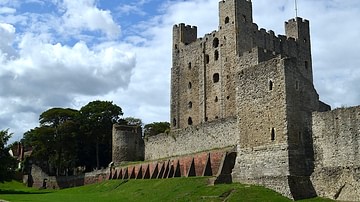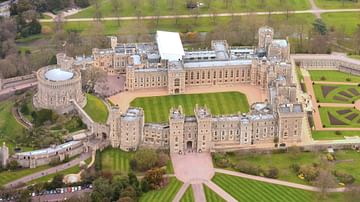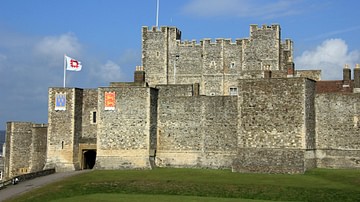If one was looking to enjoy a fine meal in the medieval world then the best place to find a handsomely laid dinner table was in the local castle. There, in the magnificent Great Hall, feasts were regularly served for the local lord and his entourage of knights and ladies where a hearty appetite was considered a great virtue. The cooks in the castle kitchens could draw on the castle's own food stores made plentiful with goods either paid in tax by, or commandeered from, the local peasantry or the foodstuffs produced from the castle's own lands. Supplementing these goodies was anything that the castle residents could bring in from their frequent hunting trips in the local forests. With not much else going on by way of regular entertainment, a good banquet was a highlight of the day and a chance to dress up, try out some exotic foods and be entertained by musicians and poets.
The Food Supply
Castles could store plenty of foodstuffs in the basement and ground floor of the tower keep as, without windows (to improve security during a siege), this part of the building was not much good for anything else. In the courtyards of larger castles there were other buildings for brewing beer, making bread, and more storage space such as the buttery which was used to keep a plentiful stock of beer, wine and cider (always useful if the water ran out during a prolonged attack). There might also be a more select stock of spirits such as English mead or French brandy, kept in reserve for the lord and special occasions. In larger castles there was, too, space for keeping livestock, perhaps a dovecote for pigeons, a granary for keeping grain and flour, a pond for fish and a garden for growing herbs, fruit, vines and vegetables.
The foodstuffs came from the castle's own animals and lands or were paid to it as a form of tax by local farmers. It was the responsibility of the lady of the castle to oversee all the domestic aspects of castle-life including the food supply (although a local sheriff actually procured the food required from peasants), the daily menu and the care of any guests. Food supplies were not always regular, of course. Adverse weather conditions hit agriculture and disrupted availability, sending prices rocketing and making certain foods unobtainable. Food production, as with most other human activities, was especially hit by such catastrophic events as war, famine and plague. Still, in the normal course of events, a daily dinner at the castle was an event not to be missed.
The Great Hall
In the Great Hall of the castle, which usually had an impressive high ceiling (perhaps even a vaulted one) and wall decorations of weapons, wall hangings, murals and coats of arms, there was a large fireplace for warmth and long tables with benches set around the walls for the diners. Even the floor was taken care of and spread with straw and herbs to keep out pests and provide a little fragrance. Seating arrangements were quite well defined. The lord and lady of the castle with their immediate entourage usually sat on a raised platform at the end of the hall - the original high table and usually the most draught-free spot. Only the lord of the castle and sometimes his lady sat on a chair; everyone else had to make do with the benches. The tables were simple affairs set on trestles which were only set up at mealtimes. Laid with a tablecloth, each place had a knife, spoon, and cup while shared between diners were jugs for drinking and a dish for salt.
After normally having eaten a meagre breakfast of bread and wine, and with only a simple supper in the later afternoon to look forward to, the diners would have been ready for their big meal of the day, usually served between 10 am and 12 noon. If it were a festival or a Christian holiday, then the meal, ordinarily a pretty good one anyway, would be an extra special feast. Dinner was announced by a chamberlain blowing a horn which was the signal for everyone to wash their hands in the bowl of water at their place. As there were no forks and people cut up food with a knife and then used their fingers, retainers were always on hand with fresh bowls of water and towels. Curiously, dishes were served for two people and the less distinguished of the pairing was expected to cut the food and break the bread for the other. Other conventions of decorum were not to put one's elbows on the table, not leave a spoon in the shared dish, not to take huge helpings, wipe the mouth before drinking, and never belch.
The Kitchen
Chefs were assisted, depending on the size of the castle, by such skilled specialists as a sauce chef, a slaughterer, a baker, a poulterer and a fruiterer. Other staff included cupbearers, brewers, and people responsible for specific aspects of the medieval dining experience like the tablecloths, the candles, the silver dining service and getting the food to the guests from the kitchen before it got stone cold.
Chefs had a large open fire, spit braziers and an oven with which to whip up their magic. Some ovens were huge, as those commissioned by King John of England at both Marlborough and Ludgershall castles where they were large enough to accommodate a whole oxen. By the kitchen was a pantry where such goodies as cheese, eggs and bread were stored.
The Medieval Feast
The one thing that differentiated the medieval rich from the poor more than any other in terms of food was meat. Meat could be fresh, salted or smoked, and included chicken, bacon, pork, beef, mutton, duck, geese, pigeons, and wild birds such as pheasants and partridges. For the more adventurous diner there were cranes, larks and herons but just about anything with wings on it could find its way onto a castle dinner table. Then there was four-legged game such as deer, hares and boars which were all captured on a hunt, an especially popular pastime for those rich enough not to have to work for a living. More exotic fare included swans and peacocks, which made especially impressive presentation dishes.
The fashion in the Middle Ages was to boil meat in large cauldrons, a process known as 'seething'. Alternatively, it was roasted or grilled while meat stews and soups were prepared, too. Meat dumplings were made from minced meat mixed with egg and breadcrumbs and then poached. There was also a dish where meat was pounded into a paste and mixed with boiled rice. Finally, meat pies, pastries and fritters were prepared, and there were fish pies, too. Commonly eaten fish included herring, cod, trout, sole, plaice, salmon, bream, pike, mackerel and mullet. Fish was fresh or had been smoked or salted to preserve it. It was usually fried or cooked in a mix of ale and saltwater. The most exotic and expensive examples of seafood were sturgeon and whale, both known as the “royal fish” but there were also crayfish, eels, oysters and porpoise if the host wanted to impress his guests.
The most common vegetables were peas and beans but there were also root vegetables such as carrots, parsnips, and burdock as well as lettuce, beets, cabbage, spinach, leeks, pumpkins and watercress. Capers and nuts were favourites. Bread, darker than we are used to today because of the lack of refined flour, besides being a handy filler, was also used as a plate. Roast meat, in particular, was often served on a thick slice of one-day-old bread (a trencher or manchet) while other dishes came in bowls.
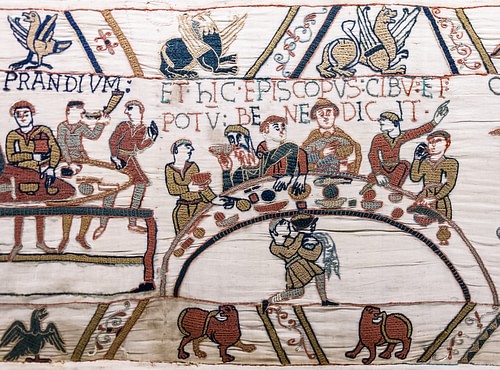
Dessert consisted of cheese, wafers and pastries such as fruit or cheese tarts. Fruits included apples, pears, plums, peaches, cherries and wild fruits. For the wealthiest of castle hosts, the exotic foodstuffs to be found on his table, which were brought in from abroad, included rice, almonds, raisins, oranges, pomegranates, figs and dates.
Food could be seasoned using salt, vinegar, mustard, aniseed, and herbs (e.g. basil, fennel, rosemary, parsley, sage and mint). Honey was a common sweetener as was special sugar, sometimes made with roses and violets. Sauces were prepared by grinding herbs and mixing them with wine, the juice of unripe grapes (verjuice), or vinegar. Onions, garlic, ginger, saffron, cloves, nutmeg and cinnamon were also in the chef's repertoire to make the mundane more interesting and mask the taste of any meat that had not fared so well in the castle's larder. Spices were expensive, though, with 30 grammes of pepper, for example, costing the day's wages of a labourer.
For drinks, there was wine, always drunk young as nobody had yet invented a good way to seal and store it indefinitely. Decanted from barrels into jugs it might have a few little additives like spices or sweeteners which was just as well because it was usually not very good according to several medieval commentators. Alternatively, but not really for the distinguished guest, there were beers and ales made from barley, malt, wheat or oats. Being weak in alcohol content it was also drunk by children. Water was none too clean and best avoided.
All of this food could be spread over many courses, sometimes up to ten in a single meal. The diners need have no fear of seeming a bit greedy, though, as a good appetite was considered a great virtue in the medieval world. Indeed, there were even such sayings as 'a man who eats heartily will never prove to be a coward' and knights, especially, probably tried to outdo each other on just how much food and drink they could put away. One of the most famous of all knights, the Englishman Sir William Marshal (c. 1146-1219 CE) was known as 'the glutton' or gaste-viande in his youth, and it was a term of endearment rather than criticism. Similarly, another knight, Guy de Bourgogne, seems to have gone out of his way to impress his Saracen captors who reported that he had the appetite of four men.
Entertainment
While the guests were tucking into all this hearty fare, jugglers and jesters performed, perhaps a harpist offered some unobtrusive background music and minstrels sang and played the lute or vielle (an early version of the violin) for their entertainment. After the meal, guests who still felt up to it could play games such as dice, backgammon or the hugely popular chess, all of which might involve a bit of betting. Alternatively, the minstrels belted out a few songs, the chanson de gestes and chansons d'amour, actually epic poems in Old French which told familiar stories of knightly daring deeds and impossible romances respectively. One or two of the guests might perform songs they had themselves composed, such was the expectation upon a chivalrous knight and a suitable recompense for the host's generosity in offering such a fine dining experience.


